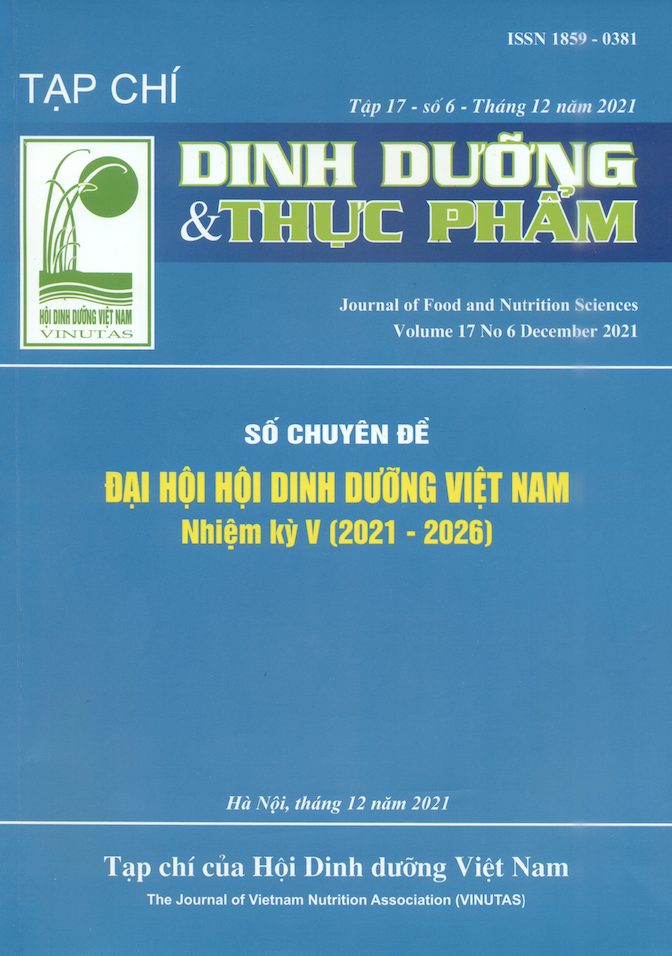Nutritional status and actual dietary intake of pre-eclampsia patients at the national hospital of Obstetrics and Gynecology in 2021
Main Article Content
Abstract
Objectives: To assess nutritional status and describe actual dietary intake of pre-ec- lampsia patients at the National Hospital of Obstetrics and Gynecology in 2021. Methods: a cross-sectional descriptive study on 100 pre-eclamptic patients was conducted.
The patient's weight and height were measured. Blood biochemical indicators were tested, and dietary intake was investigated by the 24-hour recall method. Results: 47% of the women gained the recommended weight; 40% of patients were anemic. Most of the study subjects did not meet the recommended requirements for energy-generating nutrients, and vitamins as well as some minerals. More specifically, 72% of patients did not meet the recommended energy needs. The percentage of patients whose diets did not meet the RDA on vitamin E, vitamin D, vitamin B12, vitamin A, vitamin K, calcium, iron, and Ca/P ratio accounted for 82%, 77%, 67%, 65%, 55%, 35%, 62%, respectively. Conclusions: More than half of patients (53%) with pre-eclampsia did not gain the recommended weight. The actual diets of patients with pre-eclampsia mostly did not meet the recommended requirements for energy and nutrients.
Keywords
Nutritional status, actual diet, pre-eclampsia, the National Hospital of Obstetrics and Gynecology
Article Details
References
2. Schoenaker DA, Soedamah-Muthu SS, Mishra GD (2014). The association between dietary factors and gestation- al hypertension and pre-eclampsia: a systematic review and meta-analysis of observational studies. BMC Med, 12(1), 157.
3. Alane Cabral Menezes de Oliveiraa, Ar- ianne Albuquerque Santosb, Alexandra Rodrigues Bezerra, et al (2016). Intake of antioxidant nutrients and coefficients of variation in pregnant women with pre- eclampsia. Cardiologia, Vol. 35, Issue 9, 469-476.
4. L. Anne Gilmore and Leanne M. Redman (2014). Weight gain in pregnancy and application of the 2009 IOM guide- lines: toward a uniform approach. Obesity (Silver Spring, Md.) 23(3), 507–511.
5. Bộ Y tế (2017). Hướng dẫn quốc gia dinh dưỡng cho phụ nữ có thai và bà mẹ cho con bú. Ngày 8/3/2017, Bộ Y tế, trang 36.
6. Samur G, Ozpak Akkus O, Ede G, et al (2016). Nutritional status among women with preeclampsia and healthy pregnant women. Prog Nutr, 18, 360-368.
7. Văn Quang Tân (2015). Thực trạng tình trạng dinh dưỡng trước – trong thời kỳ mang thai của bà mẹ và chiều dài, cân nặng của trẻ sơ sinh tại tỉnh Bình Dương. Luận án Tiến sỹ y tế công cộng, Trường đại học Y tế Công cộng.
8. Goldstein RF, Abell SK, Ranasinha S, et al (2017). Association of Ges- tational Weight Gain with Maternal and Infant Outcomes: A Systematic Review and Meta-analysis. JAMA, 317(21), 2207-2225.
9. Casey GJ, Phuc TQ, MacGregor L, et al (2009). A free weekly iron-folic acid supplementation and regular deworm- ing program is associated with improved hemoglobin and iron status indicators in Vietnamese women. BMC Public Health, 9(1), 261.
10. De-Regil LM, Palacios C, Lombardo LK, Peña-Rosas JP (2016). Vitamin D supplementation for women during pregnancy. Cochrane Database Syst Rev, (1): CD008873.


